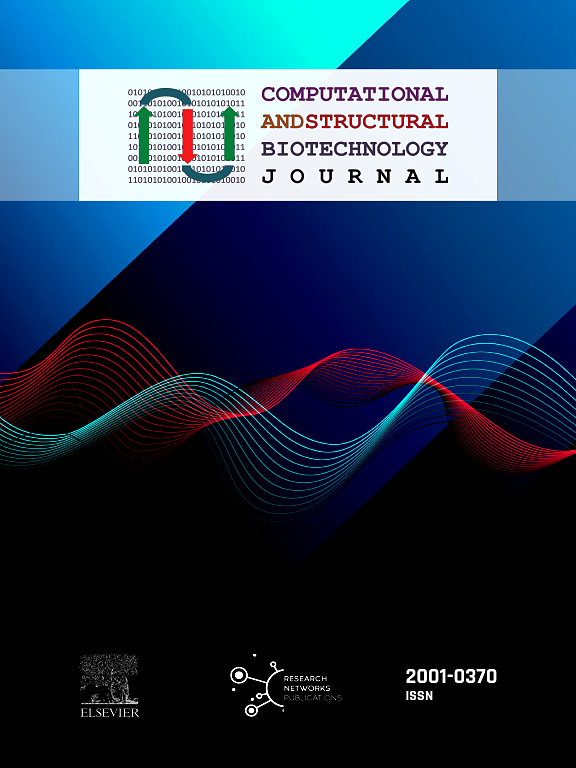NJGCG: A node-based joint Gaussian copula graphical model for gene networks inference across multiple states
IF 4.4
2区 生物学
Q2 BIOCHEMISTRY & MOLECULAR BIOLOGY
Computational and structural biotechnology journal
Pub Date : 2024-08-22
DOI:10.1016/j.csbj.2024.08.010
引用次数: 0
Abstract
Inferring the interactions between genes is essential for understanding the mechanisms underlying biological processes. Gene networks will change along with the change of environment and state. The accumulation of gene expression data from multiple states makes it possible to estimate the gene networks in various states based on computational methods. However, most existing gene network inference methods focus on estimating a gene network from a single state, ignoring the similarities between networks in different but related states. Moreover, in addition to individual edges, similarities and differences between different networks may also be driven by hub genes. But existing network inference methods rarely consider hub genes, which affects the accuracy of network estimation. In this paper, we propose a novel node-based joint Gaussian copula graphical (NJGCG) model to infer multiple gene networks from gene expression data containing heterogeneous samples jointly. Our model can handle various gene expression data with missing values. Furthermore, a tree-structured group lasso penalty is designed to identify the common and specific hub genes in different gene networks. Simulation studies show that our proposed method outperforms other compared methods in all cases. We also apply NJGCG to infer the gene networks for different stages of differentiation in mouse embryonic stem cells and different subtypes of breast cancer, and explore changes in gene networks across different stages of differentiation or different subtypes of breast cancer. The common and specific hub genes in the estimated gene networks are closely related to stem cell differentiation processes and heterogeneity within breast cancers.NJGCG:基于节点的联合高斯共轭图模型,用于跨多状态的基因网络推断
推断基因之间的相互作用对于了解生物过程的内在机制至关重要。基因网络会随着环境和状态的变化而变化。通过积累多种状态下的基因表达数据,可以根据计算方法估计不同状态下的基因网络。然而,现有的基因网络推断方法大多侧重于从单一状态估计基因网络,而忽略了不同状态但相关的网络之间的相似性。此外,除了单个边缘外,不同网络之间的相似性和差异也可能是由中枢基因驱动的。但现有的网络推断方法很少考虑中枢基因,从而影响了网络估计的准确性。在本文中,我们提出了一种新颖的基于节点的联合高斯协图谱(NJGCG)模型,用于从包含异质样本的基因表达数据中联合推断多个基因网络。我们的模型可以处理各种缺失值的基因表达数据。此外,我们还设计了一种树状结构的群体套索惩罚(group lasso penalty),以识别不同基因网络中的共性和特异性枢纽基因。模拟研究表明,我们提出的方法在所有情况下都优于其他同类方法。我们还应用 NJGCG 推断了小鼠胚胎干细胞不同分化阶段和不同亚型乳腺癌的基因网络,并探讨了基因网络在不同分化阶段或不同亚型乳腺癌中的变化。估算出的基因网络中的共性和特异性枢纽基因与干细胞分化过程和乳腺癌内部的异质性密切相关。
本文章由计算机程序翻译,如有差异,请以英文原文为准。
求助全文
约1分钟内获得全文
求助全文
来源期刊

Computational and structural biotechnology journal
Biochemistry, Genetics and Molecular Biology-Biophysics
CiteScore
9.30
自引率
3.30%
发文量
540
审稿时长
6 weeks
期刊介绍:
Computational and Structural Biotechnology Journal (CSBJ) is an online gold open access journal publishing research articles and reviews after full peer review. All articles are published, without barriers to access, immediately upon acceptance. The journal places a strong emphasis on functional and mechanistic understanding of how molecular components in a biological process work together through the application of computational methods. Structural data may provide such insights, but they are not a pre-requisite for publication in the journal. Specific areas of interest include, but are not limited to:
Structure and function of proteins, nucleic acids and other macromolecules
Structure and function of multi-component complexes
Protein folding, processing and degradation
Enzymology
Computational and structural studies of plant systems
Microbial Informatics
Genomics
Proteomics
Metabolomics
Algorithms and Hypothesis in Bioinformatics
Mathematical and Theoretical Biology
Computational Chemistry and Drug Discovery
Microscopy and Molecular Imaging
Nanotechnology
Systems and Synthetic Biology
 求助内容:
求助内容: 应助结果提醒方式:
应助结果提醒方式:


